Responsible Decision-Making
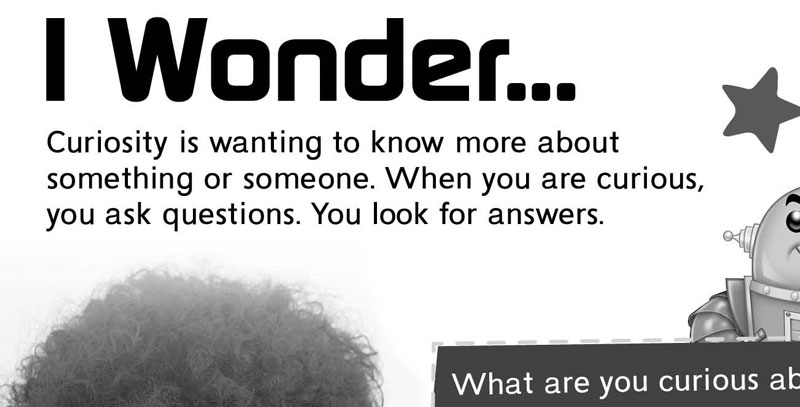
Find this activity in the student portfolio
Objective: Students will demonstrate open-mindedness and curiosity.
Estimated Duration: 15-20 minutes
Description: Curiosity is having a strong desire to learn or know something. Curious students not only ask questions, but they actively seek out the answers. Curiosity supercharges learning.
The greatest advantage of curiosity lies in its ability to motivate learning in areas of life that are meaningful to the learner. It points students toward the knowledge, skills, relationships, and experiences that will make their lives full and rewarding.
Before beginning this activity, show students a variety of examples of creative works. Discuss how the examples show different forms of creativity.
This activity will get students to use their creativity skills by drawing what they wonder about animals, people, and places.
Teachable Moments: To help students have an open-mind and think creatively:
- Model curiosity in the classroom. You can do this with students by exploring their interests, expanding upon their ideas, and engaging them in meaningful dialogue about what matters most.
- Change your daily routine in the classroom. Make a small tweak here and there occasionally to show students that it is okay to do things differently sometimes.
- Read a joke book with your class. Sometimes, rigid thinkers have a difficult time understanding jokes or making up their own jokes. Joke books are a good way to talk about the different meanings of words and to think about changing the meaning of a word to make it funny.
- Notice and reward curiosity when you see it in action. When you praise students by describing how their questions, explorations, and investigations are contributing to their own or classroom learning, you let them know that they are valued for their motivation, regardless of their grades.
- Teach students quality questions. Good questions contain "why," "what if," and "how."
- Encourage students to tinker. Tinkering might be constructive play with feelings, concepts, ideas, and materials. Tinkering with materials, thoughts, and emotions stimulates curiosity and leads to innovative outcomes.
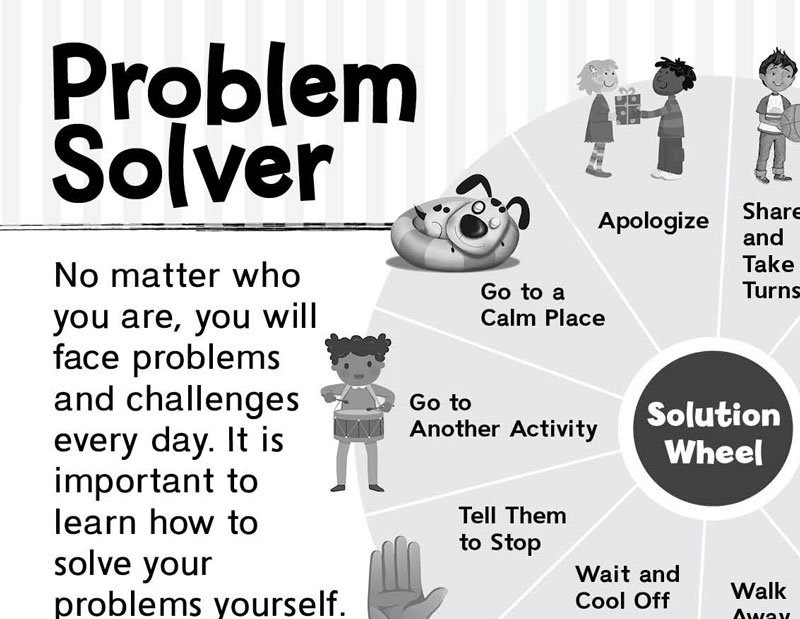
Find this activity in the student portfolio
Objective: Students will identify solutions for problems.
Estimated Duration: 15 minutes
Description: Problem-solving is a foundational skill for students to learn, that allows other skills such as creativity and innovation to thrive. When students face problems or conflict in their everyday lives, problem-solving skills become essential.
Rather than becoming frustrated when confronted with the problem—such as a disagreement with a friend or a lost toy—problem-solving skills allow students to manage their emotions, think creatively, and discover thoughtful solutions.
Before beginning this activity, ask students to think about a problem that has happened to them. It could be a big problem or a small problem. Lead a discussion to brainstorm ways to solve the problem.
Let students come up with their own solutions and work through the problem-solving process. Allow students to be creative with their solutions.
In this activity, students will be asked to name a problem they have. Then, they will be asked to draw the strategy they will use to solve their problem. They will have a wheel of problem-solving strategies to choose from.
Teachable Moments: To help students determine solutions for problems:
- Encourage and normalize failure in the classroom. Failure allows students to learn how to deal with disappointment, manage stress, and come up with problem-solving techniques on their own.
- Encourage students to take the lead. It is important for them to understand that you are there to help guide them, but it is important that you ultimately let allow students to solve the issue independently.
- Ask open ended questions when students ask for help. Here are some examples of open-ended questions you can ask “Why did you chose to...?”; “What do you think will happen if...?”; “What makes this work?”; What do you notice?”
- Use brainstorming activities in the classroom. Have your students brainstorm solutions relevant to what you are currently teaching. They could imagine ways historical figures or characters might have done things differently to produce better results. This type of brainstorming pushes children to think about multiple scenarios or solutions to a problem.
- Model how to use problem-solving strategies by asking clarifying questions if you don’t understand something, admit when you don’t know an answer, talk through multiple possible outcomes for different situations, and verbalize how you are feeling when you encounter a problem.
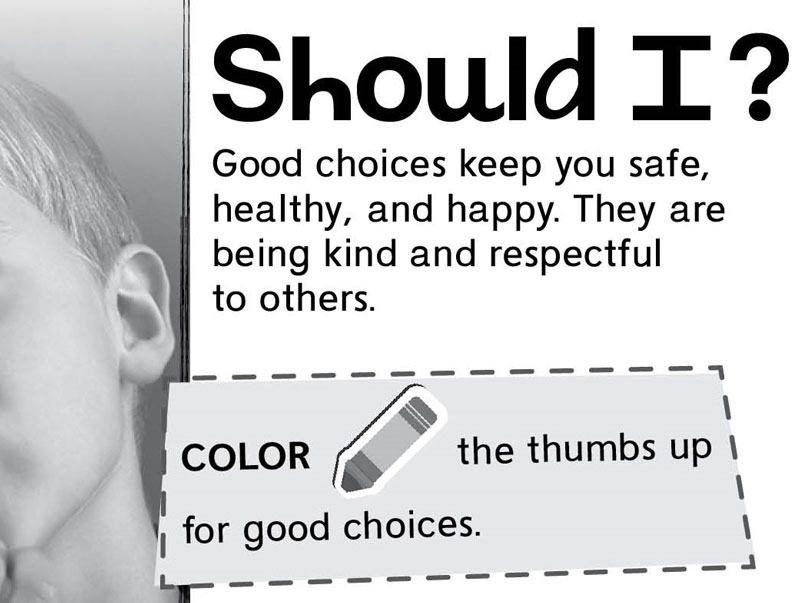
Find this activity in the student portfolio
Objective: Students will be able to understand the importance of making good choices for themselves and others.
Estimated Duration: 15 minutes
Description: Learning how to be a decision-maker is a lifelong skill, so it is important that students at this age begin by understanding what good choices are.
Start by teaching students that good choices help to keep them safe, healthy, and happy. Good choices should make them feel good about themselves as well as how they treat others.
Before beginning this activity with students, talk to them about what a good choice is. Ask them to share good choices that they make for themselves and others.
This activity will help students understand good choices. They will color the examples of good choices.
Teachable Moments: To help students understand what good choices are:
- Model and role play making good choices with students. Talk to students about consequences. What happens when they make good choices? What happens when they make choices that are not so good?
- Play games that help students sort or match good choices and not so good choices.
- Create a choice board for center or play time. Let students decide where they want to go. Have them hang a name tag on the chart for where they choose to play or work.
- Change demands for making good choices into asks. Instead of saying: "Share the dinosaurs!" Say: "I see you like playing with the dinosaurs. Which dinosaur would you like to use? The green dinosaur or the blue dinosaur?"
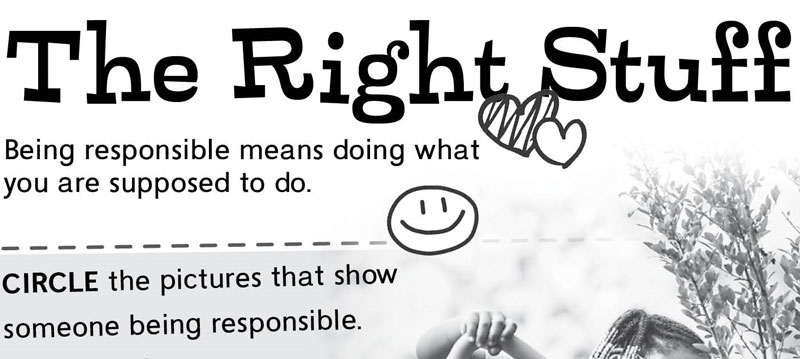
Find this activity in the student portfolio
Objective: Students will understand what it means to be responsible.
Estimated Duration: 15 minutes
Description: Being responsible means to be accountable for what you do, for your actions and behavior. It is doing the right thing at the right time, so others can trust and depend on you.
Before beginning this activity, ask students to tell you what it means to be responsible. Give them examples of how you are responsible. Ask them to share examples.
This activity will help students think about being responsible. They will circle pictures that show responsibility and cross out ones that do not.
Teachable Moments: To help students be responsible:
- Read books that have characters who behave responsibly or who do not and talk about the consequences.
- Have students make coupons for tasks they can do at school or at home to be responsible (e.g., return borrowed items, complete homework on time, brush teeth, help with the dishes, etc.)
- Model responsibility and talk about it. Say things like, "I am putting this back on my desk, so I know where it is."
- Let students help, even if it takes longer or is not the way you would typically do it.
- Build a classroom job system. Use pictures to help students understand the jobs that need to be done and how to do them.
Foldable®: If...Then Moments
Estimated Duration: 25-30 minutes
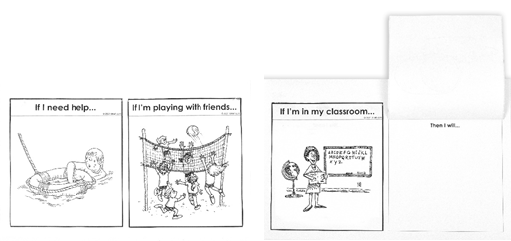
- Cut along the outside solid black lines of the four One-Tab Foldables.
- Fold along the dotted line at the top of each rectangle to form an anchor tab.
- Glue the folded tabs on top of the four gray areas in the student book. Match the tab titles before gluing.
- On each tab, students observe the picture and the If statement. Under the tabs, students draw their Then responses.
- Discuss how there are many ways to respond to If…then statements. If students are playing with friends, then…they might have to share, take turns, compromise, help someone, wait for something, work together, and more.
Go to other SEL competencies in this book (Primary 1 - Grades PreK–K):
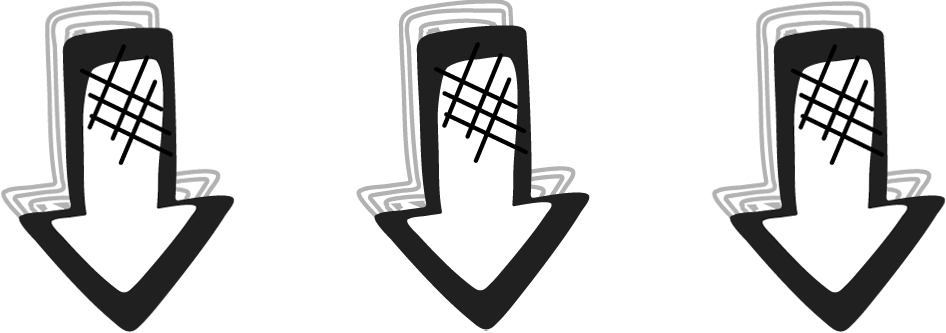
The teaching suggestions only work in accompaniment with the student portfolio, which has all the activity pages.
The teaching suggestions here are also available within a PDF of the entire teacher's manual.